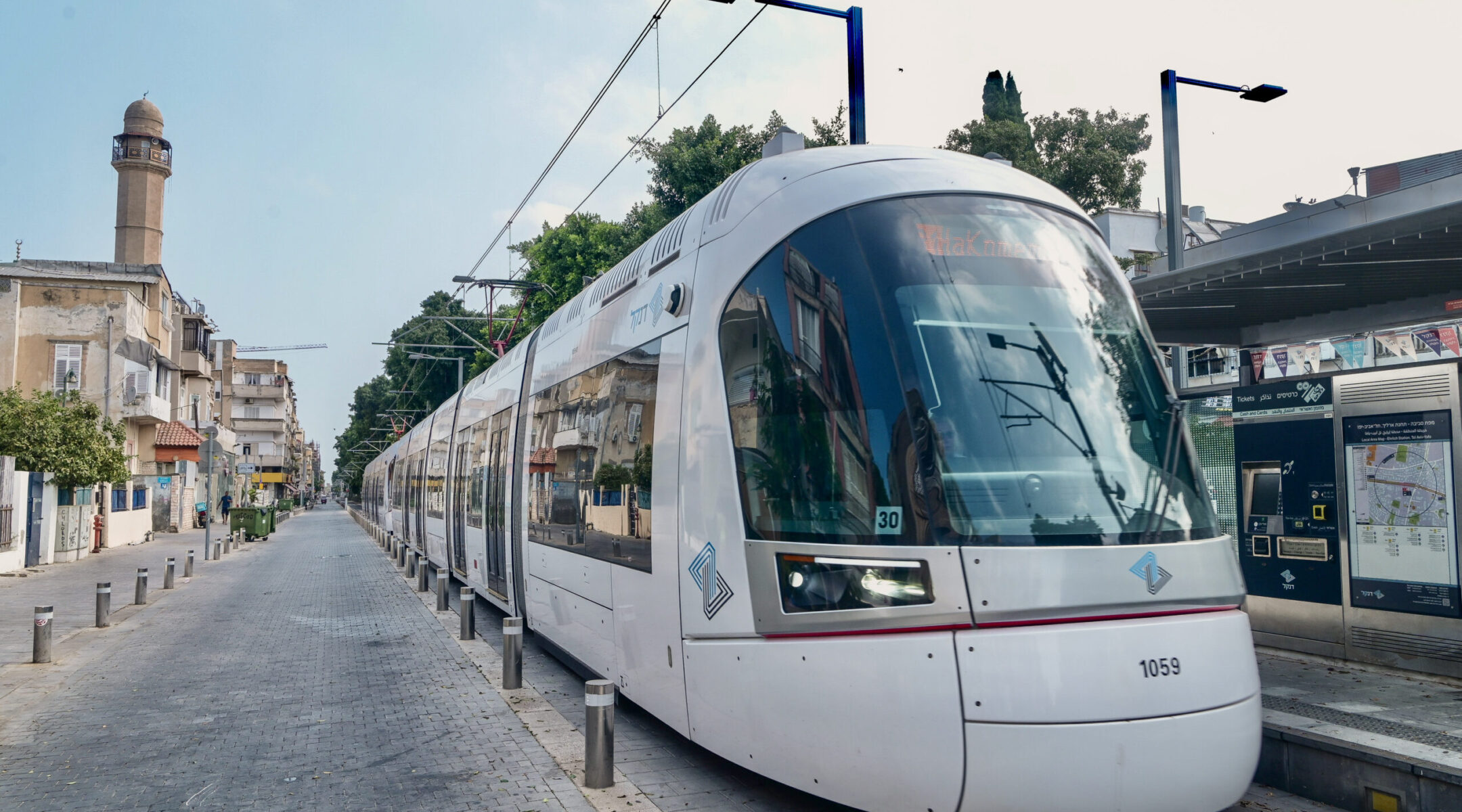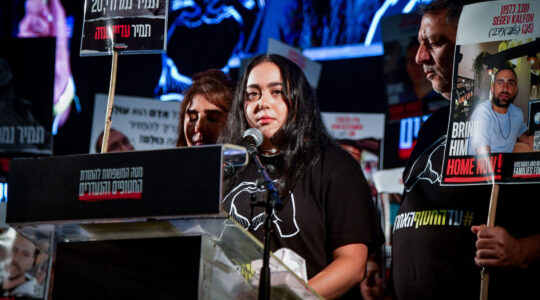TEL AVIV (JTA) — The sounds of protest echoed and the ticket scanner malfunctioned as Israel’s transportation minister, Miri Regev, led a dry run for journalists of Tel Aviv’s long-awaited light rail on Wednesday.
The landmark project, which cost nearly $5 billion, promises to reshape the experience of commuting to Tel Aviv, or moving within it, for countless Israelis. The Red Line, whose route runs through Bat Yam, south of Tel Aviv, through Tel Aviv to Petah Tikva, will officially open to the public on Friday — eight years after construction began and two years after it was first set to open.
The country has changed in that time. Now, government ministers cannot make public appearances without drawing protests from Israelis who are upset about the eight-month-old coalition’s efforts to limit the power of the judiciary.
Protesters gathered at Ehrlich Station on Jaffa’s main artery, Jerusalem Boulevard, ahead of Regev’s arrival, chanting, “The minister poses for photo ops while the country is collapsing.” Others followed Prime Minister Benjamin Netanyahu to his appearance at the official opening ceremony in Petah Tikva on Thursday.
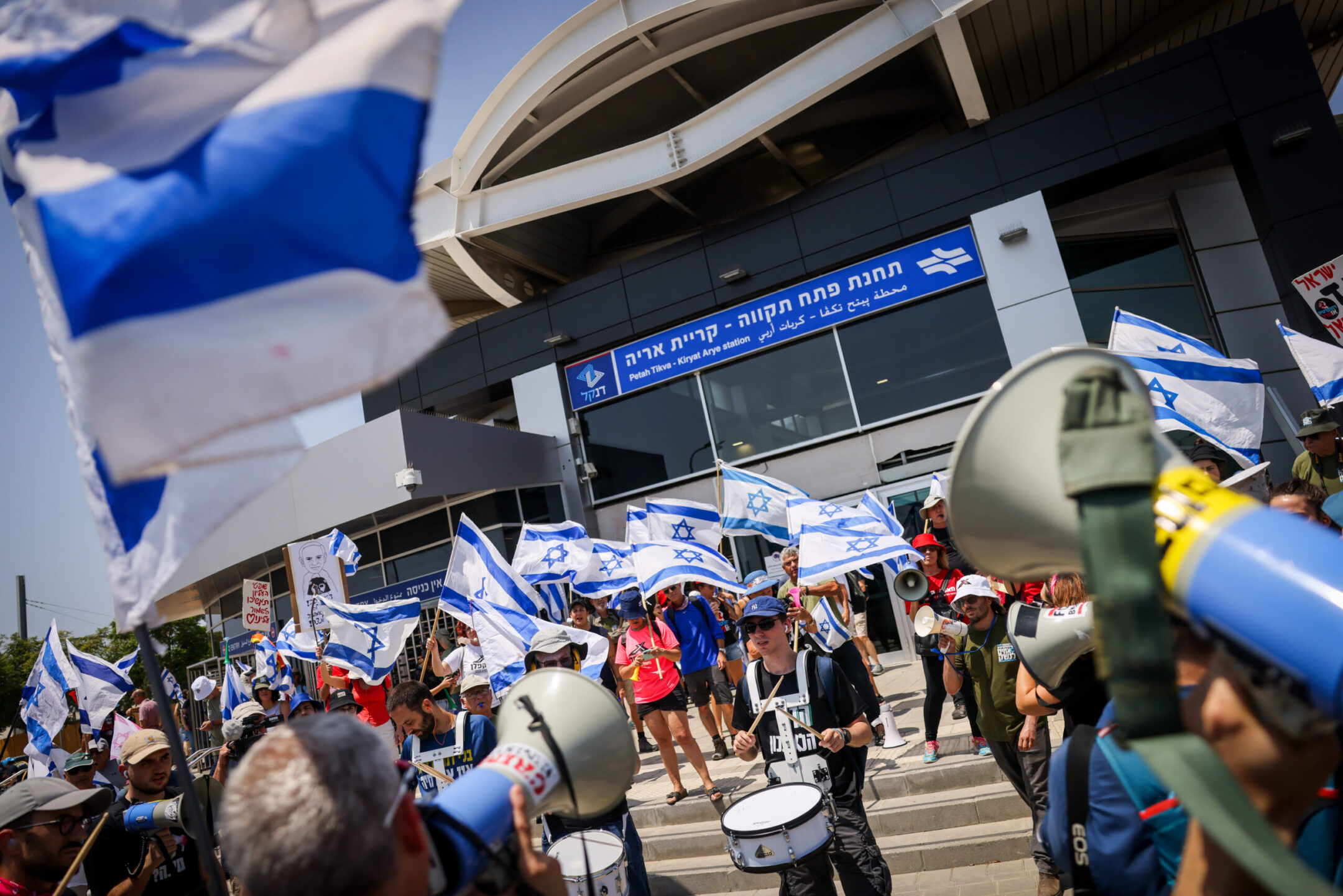
Anti-overhaul activists protest against Israeli Prime Minister Benjamin Netanyahu before the opening ceremony of the light rail, in Petah Tikva, Aug. 17, 2023. (Chaim Goldberg/Flash90)
For many residents, one of the key issues clouding the light rail’s inauguration is that it will not run on Shabbat. Regev’s predecessor, Merav Michaeli, had promised that the line would run on Friday evenings and all day Saturday — a rarity in a country where public transportation does not operate on Shabbat. (An exception is in Haifa, which has a large Arab population.)
Michaeli’s promise had prompted outrage in the haredi Orthodox suburb of Bnei Brak, which has several stops on its route. Earlier this month, Regev announced that she was reversing Michaeli’s decision.
“We will uphold the status quo, according to which the train will not operate on Shabbat. For non-religious people, Shabbat is also a day of rest. And this is a Jewish state,” Regev told journalists on Wednesday.
As it stands, the line will operate for only 45 minutes on Saturday evenings, a shorter period than Jerusalem operates its light-rail system.
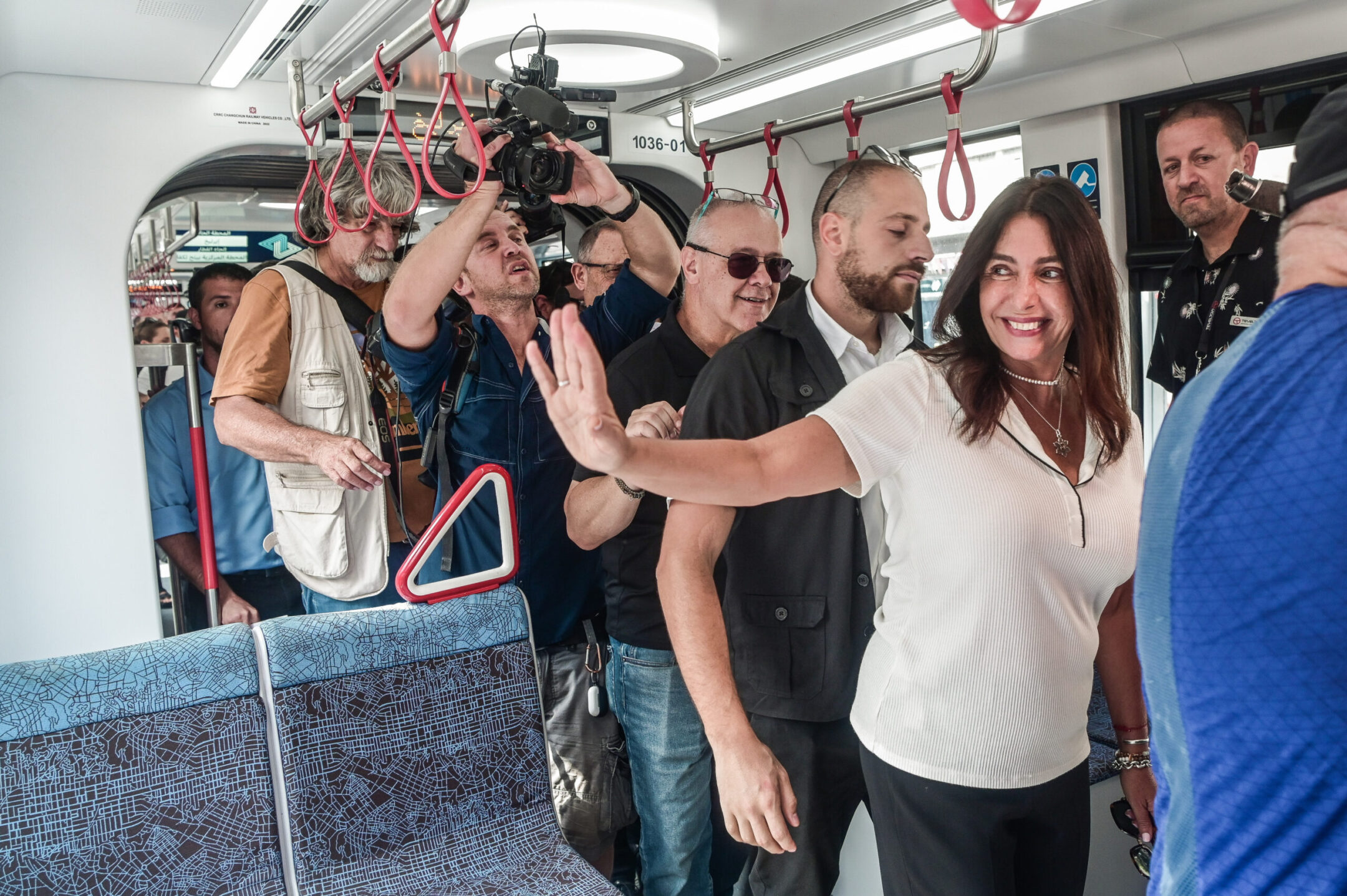
Miri Regev, Israel’s transportation minister, hosts a test drive of the new Metropolitan Light Rail in Jaffa-Tel Aviv, Aug. 16, 2023. (Avshalom Sassoni/Flash90)
Tel Aviv Mayor Ron Huldai skipped the opening ceremony over the Shabbat decision. Now, some critics of the government decision say they plan to boycott the train line altogether until it operates on Shabbat.
Ziv Forshtat, one of the people protesting Michaeli during the dry run, said he thought the limited service had to do with the massive anti-government demonstrations that take place after Shabbat ends each week at Kaplan Square, which is adjacent to one of the light-rail stations.
“They don’t want to make it easier for people to come to Kaplan for the protests,” he told the Jewish Telegraphic Agency.
Forshtat said he thought it was important that Israelis who have protested the right-wing government’s judiciary legislation should add the issue of transportation on Shabbat to their agenda.
“It’s a situation that has been tolerated until now,” Forshtat said. “But now that we’re seeing the belt tightened in other areas with this government, it’s time to put our foot down on this issue also.”
The other six days of the week, the new train line will ease for many Israelis what can be a complicated, congested journey to and through Tel Aviv. Traveling into the center of the city from either of the terminuses of the train line can take up to an hour by bus; driving by car, which not all Israelis can do, comes with a hefty price tag for parking — if a spot can even be found. Now, it will take just minutes to traverse the same distance. Areas served by the new train line are expected to become more desirable for people seeking to beat the city’s high rents.
“Whatever the problems, whatever the ‘could-have-been’s, this light rail line is a tremendous improvement over the status quo. On my route, this train line — warts and all — saves one to two hours a day,” said Owen Alterman, who works as a senior correspondent at the i24NEWS television channel. Because of poor eyesight, Alterman cannot drive and uses public transportation to get to and from the channel’s studios.
Work is underway on two additional lines that will triple the area served by light rail; those lines are for now scheduled to be completed in 2026 and 2028. The entire project will ultimately include 139 stations in 14 cities.
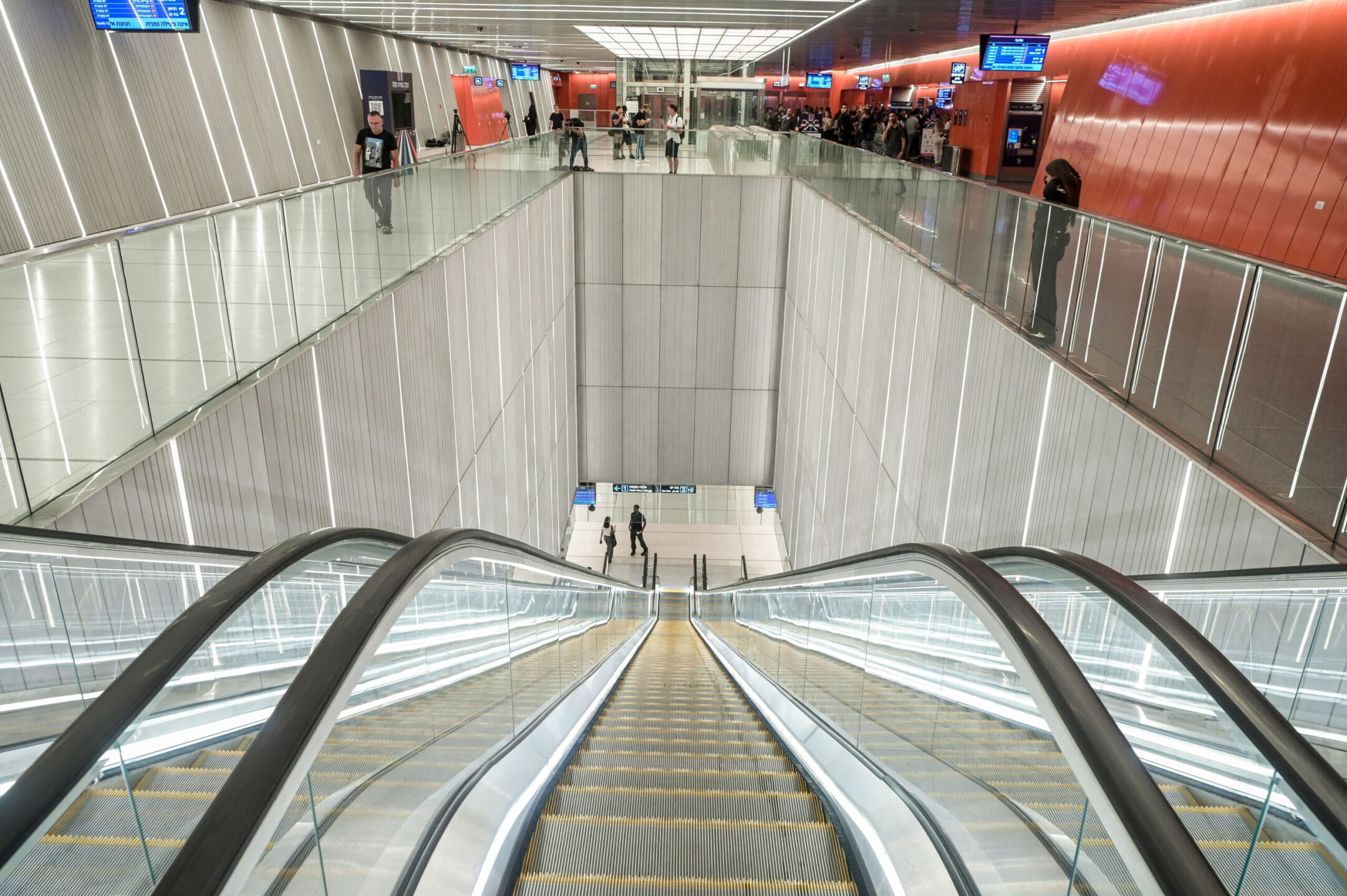
View of the new Metropolitan Light Rail station in Tel Aviv, Aug. 16, 2023 (Avshalom Sassoni/Flash90)
The 34 stations on the Red Line are gleaming in advance of the first day of operations on Friday. Unlike in Jerusalem, where a new light rail system operated fare-free for four months after the first line opened in 2011, the Tel Aviv system will start collecting fares on Saturday night. Trips within Tel Aviv will cost 5 shekels, or about $1.30, and longer trips will cost just over $3.
Some local residents had hoped that Tel Aviv would follow Jerusalem’s example and offer free rides as compensation for construction upheaval.
“After shutting down the main traffic arteries in Jaffa for four years, putting countless stores out of business and making traffic impossible in the area, the least they could offer is more than one free day,” Bracha Arnold, a Jaffa resident, told JTA.
Regev did not offer details about the transportation ministry’s decision making. “We decided that it would be one day,” she said. “From Saturday we will start validating tickets.”
How smoothly that happens remains to be seen. After Regev swiped a borrowed travel card, known as a Rav Kav, to pay a fare, the ticket barriers malfunctioned and remained closed.
“Let’s hope this gets fixed by Saturday night,” she said.
Other potential challenges loom. The train has the capacity to hold 440 passengers, but Tevel, the company that operates the line, anticipates that demand will be higher. By September, when operations normalize, the company projects demand to stand at 600 to 700 passengers per train.
The gap worries both Amiram Ohion, CEO of Tevel, the company that operates the Red Line, and Haim Glick, CEO of the government-owned mass transit agency.
“We have a passenger forecast for the route, but it is based on buses, which is a whole different world of public transportation,” Ohion said, adding that vehicle owners who traditionally shun buses may in fact choose to ride the light rail.
According to Ohion, the project was fraught with complexities, not least because it is one of only a handful of light rail systems in the world that runs both above and below ground. Ten of the 34 stations on the Red Line are subterranean, and the train runs more quickly between them.
Glick said more than 300 attendants would be deployed to assist in navigating commuters and prevent crushes.
“We also hope that the public will start acting like Europeans,” he said, noting that European capitals like London and Paris that have very busy train systems are “organized” nonetheless.
“We want people on the platform to wait for passengers to get off the train first before they try to get on.”
JTA has documented Jewish history in real-time for over a century. Keep our journalism strong by joining us in supporting independent, award-winning reporting.
